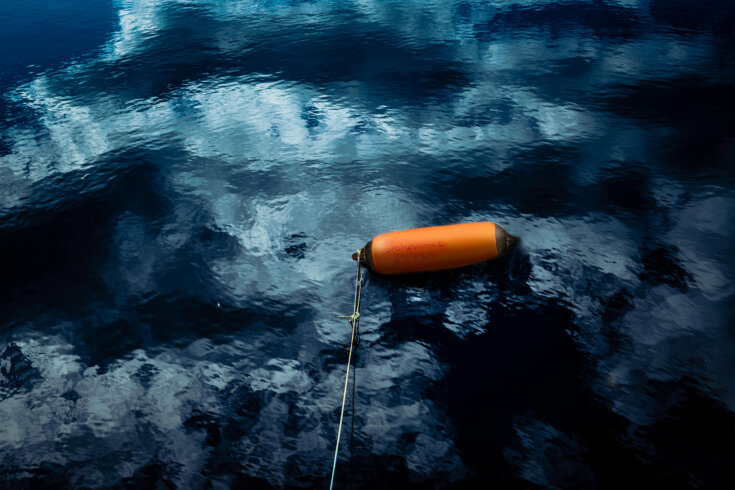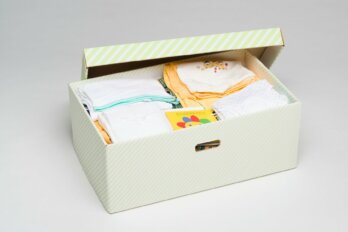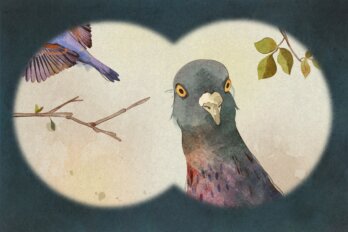“Nunaqatiga takuuk!” Ceporah called up the hillside to me. Neighbour, look! The two of us have been cabin neighbours for more than a decade; this past September, we went out on a berry-picking expedition about twenty-five kilometres from Iqaluit. I was obsessed with picking the ruby-red lingonberries bejewelling the land behind our cabins, while she had decided to comb the beach below us. Ceporah held up a bright-orange oblong buoy—the kind we use as fenders for our boats.
“Uaaik! Nanitsiasimasatit!” I called back down to her. Wow! What a great find. We love to watch for useful debris along the shores—driftwood, rope, anything possibly reusable.
“Akukittuminngaaniit!” She called back up. This is from Greenland. (The word for Greenland is the Inuktitut term referring to Greenlandic traditional fashion and is literally translated as “This is from the land of the people who wear short apron hems.”)
Ceporah scrambled up the hill to show me just how significant her find was. “Johannes Aqqalinnguaq” was scrawled across the sturdy plastic, along with a six-digit cellphone number preceded by a plus sign. With a name and phone number like that, without a doubt, this object had travelled from Greenland all the way to our cabin area.
After some quick messaging and phone calls amongst friends, we found out that the owner of the buoy was in Upernavik, in northwestern Greenland, which is also my ningaaq Edvard’s hometown. My ningaaq, my cousin’s husband, had only just been to our cabin this past summer, and at the time, he had remarked over and over again how similar the terrain was to that of Upernavik.
I asked my ningaaq to call Johannes, and when he did, the two marvelled at all the overlapping synchronicities and the roughly 1,200-kilometre distance between the spot where Johannes had lost his buoy a year ago and where Ceporah had found it. We reached out to a friend who was planning to fly from Iqaluit to Nuuk, and they agreed to bring the little buoy to my ningaaq. This method of delivery is what we call “kamik post”: from one Inuk hand to another (kamiks are sealskin boots). Inuit Nunangat—Inuit homeland—is simultaneously vast and intimate.
This past June, Air Greenland restarted its much-anticipated weekly route between Nuuk and Iqaluit, the two eastern Arctic metropolises, for the summer. There had not been a regular direct route between Greenland and Canada for nine years, and the only options during that time were sporadic and exorbitant chartered flights.
On the day of the inaugural flight, there were celebrations on both sides of the Davis Strait, which divides Greenland from Nunavut. Influencers filmed the Nuuk–Iqaluit leg for YouTube and TikTok. In Iqaluit, politicians gave speeches that played out on crackly loudspeakers. There was live square dance music and a rock concert. And from late June until nearly the end of October, a stream of families, sightseers, artists, musicians, politicians, writers, and other visitors flew back and forth on the two-hour flight.
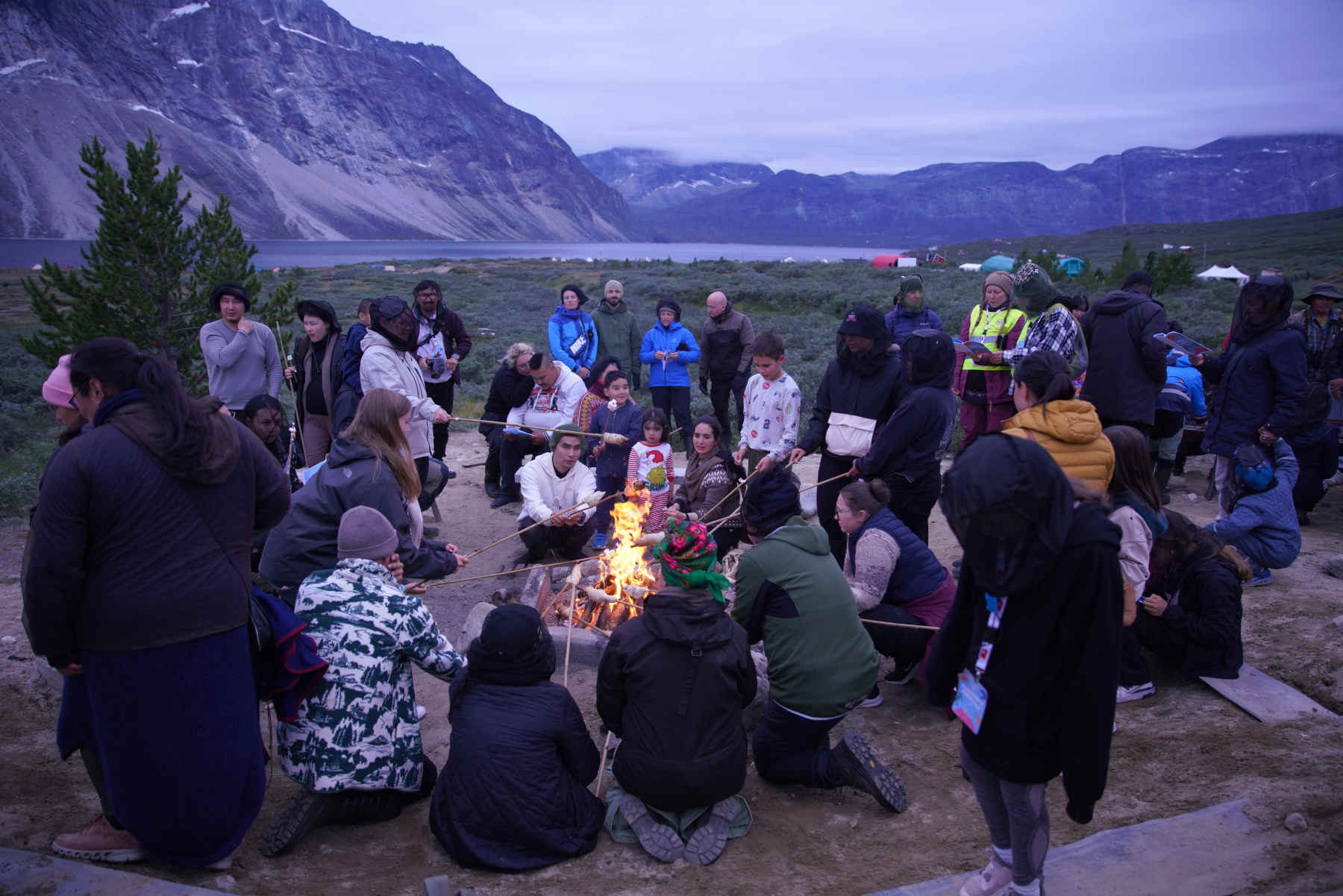
Even before the season was three quarters over, Air Greenland declared it a success and announced that it would start the route up again in April for another season. As a Greenlandic Canadian living in Iqaluit, I was glad my family got to spend the summer visiting each side of the sea. The warmth of this time will see us through the rest of the winter.
One of those visits was to Qooqqut. It was once a sheep farm on Greenland’s west coast; now it’s an area inside the extensive fjords behind Nuuk where people maintain cabins and where an enterprising restaurant attracts tourists. Every summer, for ten years now, ships have set off from Katuaq, Greenland’s national cultural centre, with technical staff, numerous coordinators, musicians, and poets and brought them all to Qooqqut for a festival. This past summer, my youngest daughter and I were lucky to be a part of it all.
When we arrived in Qooqqut, it was all hands on deck: everyone trundled up and down the dock with boxes of sugar, flour, coffee, toilet paper, speakers, drum kits, risers, amplifiers, movie screens, rifles, tents—everything we would need to live on the land together and build an outdoors, family-oriented music festival. I recalled all the old black and white photos from the 1950s that I’ve seen of Inuit unloading ships filled with goods on shores all across the Arctic—brown-skinned, wide-grinned, strong people working together—and I happily shouldered box after box with everyone else.
In Qooqqut, the bugs are thick like nothing else quite imaginable. Black flies the size of dried currants crawl into any orifice on your face unless you wear protection. Any swipe of your hand will annihilate a dozen of them. Inhaling without shielding your mouth is a sure way of choking on them. Instead of it becoming a source of panic and discomfort, the ubiquity of the bugs was a part of what created a unique camaraderie for all of us.
I worked with three other artists that week to create a collaborative concert of circumpolar artists. At nearly forty-five, I was the more mature artist but by far not the most talented or accomplished one. Nuunu Charlotte Filomensen, who turned eighteen while we worked together, is a queer singer-songwriter from Sisimiut, Greenland, whose vibrato will singe people’s hearts for decades to come. Emma Elliane Oskal Valkeapää, a twenty-four-year-old Sami singer from a reindeer herding family in Kautokeino, Sapmi (the Sami homeland), spits rhymes as easily as she joiks (joiking is the traditional Sami singing style). Byron Nicholai, a rapper, singer, and viral Yup’ik drum dancer in his mid-twenties, is from Toksook Bay, Alaska.
We were hosted by Birte Olsen, who is a music coordinator from Katuaq. Birte had us each spend a half day with one another to create new material for our concert—but not before we spent a day hiking up the river by Qooqqut to try and catch Arctic char by hand, which involves tickling the fish under their bellies as they hide in the shade of rocks. Spending time on the land together was a part of the artistic collaboration.
We didn’t have any luck with fish. During the week, we did, however, catch a caribou, to the excitement of all of Qooqqut. One day after lunch, one of the Katuaq staff spotted a caribou eating seaweed on the shore about two kilometres away. Sound checks, stage building, and meal preparation be damned, we all stopped what we were doing, and the hunt was on. While everyone else watched on with binoculars, Birte, Jaaku Søvndahl Skovaa (Katuaq’s event manager), and I ran down the valley, waded across the river, and ran up the opposite mountainside, Jaaku with a rifle and me with an ulu in hand. As caribou hunting has been severely restricted due to declining numbers on Baffin Island (where I live) for many years, I have not participated in a caribou hunt in a very long time. “There is no way I’m missing this!” I thought as I panted and sweated under my bug net and scurried along with water squelching in my boots.
Sure enough, within an hour, Jaaku got his shot in, and the three of us were happily skinning, gutting, and field-butchering the caribou. Other members of the tech crew picked us up in a Zodiac, and we brought the fresh meat to camp with much joy. That night, we ate the delectable tongue and the insides of the hooves and made a stew from the ribs that fed all of us. Our little camp finished the day with everyone singing and jamming on guitars, punctuated with contented caribou-flavoured burps.
All of this experience of being on the land together—eating and sleeping all in the same spaces—informed our collaborative concert. Emma Elliane and I created a joik-katajjaq jam based on our walk along the river. The two singing styles—katajjaq is Inuit throat singing—come from such different places and, when brought together, make an exciting, dynamic, and rhythmic sound. Nuunu and I spent a long time chatting about her long-distance girlfriend and wrote a song called “The Shy Lover,” about falling in love and coming out at the same time. (We have since professionally recorded this song, and it will be available in spring 2025.) Byron and I made a song about how big the drums in Alaska are and how, in the course of Inuit migrating from west to east, the instruments became progressively smaller, such that they are tiny in Greenland. Emma Elliane and Byron wrote a rap about Indigenous empowerment and Land Back. We each performed a solo piece—mine was a katajjaq poem called “Falestina,” drawing a parallel between Inuit relationship to nuna (the land) and Palestine.
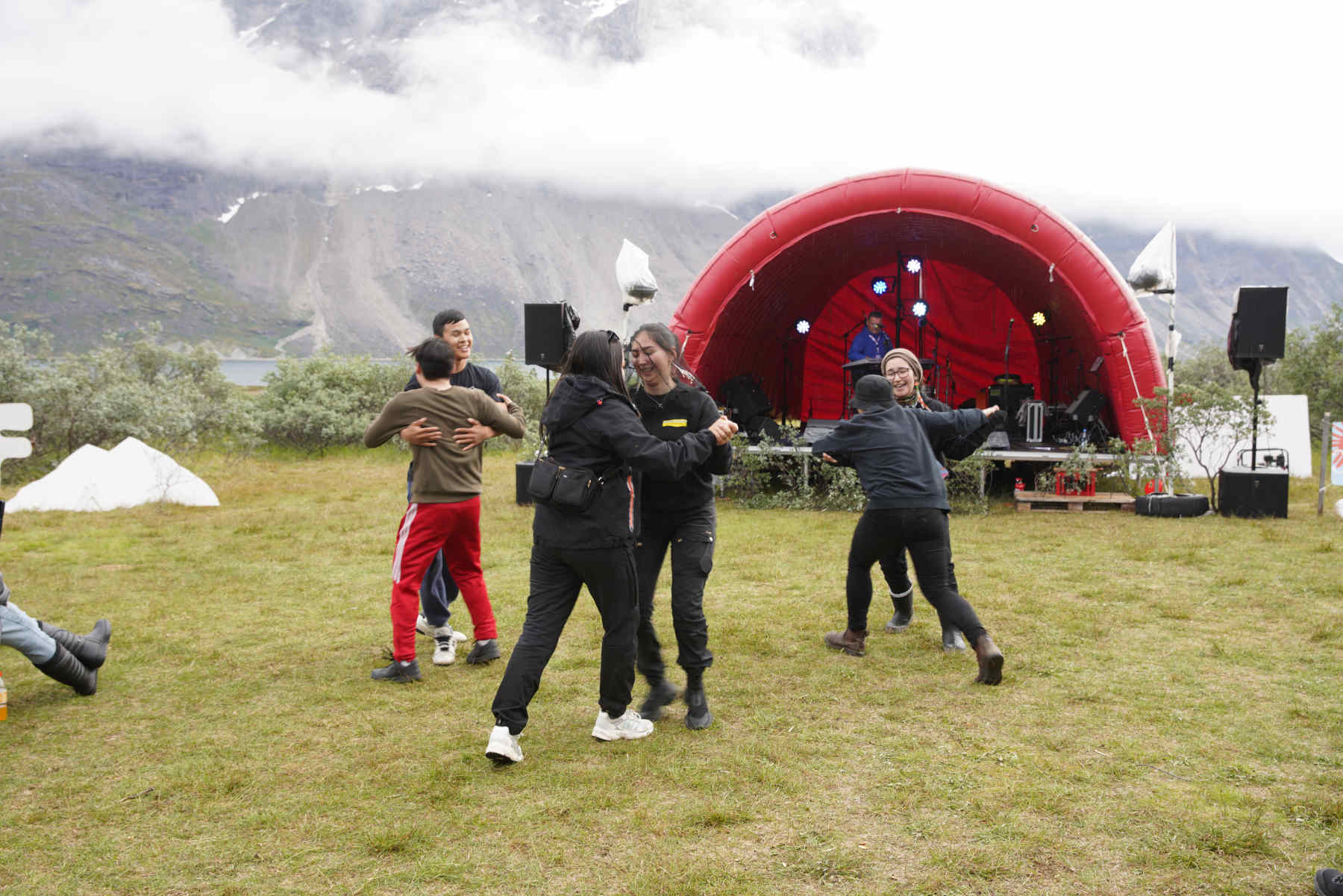
The two-day festival itself was unique, empowering, loving, sweet, and fun. Families with babies, children, teens, and elders stayed in tents all around the festival grounds, and the inlet outside Qooqqut was dotted with hundreds of anchored motorboats. Kids from Nunavut and Greenland ran up and down the community trails and around the tall, thick bushes of this place deep inside a fjord, seamlessly blending Inuktitut, Kalaallisut (Greenlandic), and English in their play. The mountains all around us shot directly up from the ocean, the rain drizzled here and there, and at the end of the day, the sun seeped away in streaks of pink and purple while we sang, danced, and played games. My little Greenlandic Canadian daughter was enthralled by every minute. And when the festival ended, everyone packed up every little bit of gear, every crumb of garbage, and left Qooqqut without a trace.
You would think this would be the end of my story, but there’s more! After we left Qooqqut, and the day we were scheduled to depart from Nuuk, I dragged my feet to the airport to check in, sad to be leaving the dozens of aunts, uncles, and cousins we have in Greenland—only to find out that our flight was indefinitely grounded.
I had a gaggle of young family members who cheered and jumped up and down on hearing the news. Other Nunavummiut at the airport were crying in confusion and shock. It took several hours to find out that Nuuk’s new airport had failed a recent international security check—which, according to the CBC, included unsecured areas of the building. International flights were allowed to land, but passengers were not allowed to depart to an international destination until security concerns were addressed. It was very convoluted and indicative only of the fact that Nuuk’s infrastructure, like Iqaluit’s, is still expanding, while staff and administration cannot always keep up with the changes.
In the end, most of the grounded passengers were flown to Copenhagen via Kangerlussuaq, the biggest international airport on Greenland’s west coast. (It was originally established by the American army in the Cold War, in the same era when the construction of the Iqaluit runway took place.) They then flew to Toronto and Ottawa and north again to Iqaluit. It took them four days to return, and some got sick along the way. My daughter and I opted to stay another week, hoping that the security issue would be resolved by the time of the next scheduled flight. We spent the week going to Maniitsoq, our family hometown, eating caribou meat, laughing and crying with all our aunts and uncles, visiting our ancestors in the graveyard, and connecting with our Kalaallit souls. Since Nuuk’s airport was still not designated an international airport by the following week, we returned to Iqaluit via Kangerlussuaq.
The common narrative amongst people living in the North is that Nunavut has a great deal of catching up to do in order to reach the same level of infrastructure development as Greenland. While it is certainly impressive that every small and large community there has a dock that all sizes of ships can tie up to, and small boat owners have access to fully maintained floating marina—things that most Nunavummiut only dream of—the reality is that Greenland has simply endured a much longer period of colonization to have built up all this infrastructure. Imperialists often credited colonization (and still do) for bringing “progress” to other cultures. Greenland’s colonial history began in 1721, while Nunavut’s colonization has mainly been taking place in the past fifty to hundred years.
Greenland, as all parts of Inuit Nunangat, used to consist of people living in outpost camps and tiny villages, focusing on fishing and harvesting from the land. Colonial governments have created Inuit communities as we know them today by relocating Inuit from homelands and birthplaces to Western-style settlements. This was done to control the population and to make capitalist gains by establishing trade outposts that Inuit were forced to rely on. Inuit now spend a lot of energy, time, and money maintaining relationships with the lands outside of the communities—a sign of our resilience. Maintaining relationships with the land is also about maintaining relationships with people from across Inuit Nunangat.
What this summer of renewed travel between the two regions—and, indeed, my whole life—has proven to me is that Nunavut and Greenland have much to share with and teach one another. We need to spend time together as Indigenous people in order to keep our cultures and languages strong as we decolonize, mitigate disaster in the face of the climate crisis, navigate increased political strife and violent wars, and participate in the global community. We need to plan for the future and appreciate our art as a tool for change.
I tell you all these stories as a reminder that Inuit maintain no borders within our culture and other circumpolar cultures; we are one people from Siberia to Alaska, all across Canada and Greenland.
Just the other day, my ningaaq Edvard got on a plane and headed north from Nuuk to Upernavik, his hometown, that orange oblong buoy strapped onto his backpack. Johannes was in a nearby village, so Edvard gave the buoy to Johannes’s daughter. They took a picture together at the municipal office, beneath the Upernavik coat of arms, surrounded by a narwhal tusk, a muskox skull, a Greenlandic and a Danish flag, and a framed image of the queen of Denmark, the buoy held between them.
The whole episode had been a perfect portrait of Inuit life: an ocean odyssey, kamik post, Inuit connection, and a little bit of spicy colonization.
With thanks to the Gordon Foundation for supporting the work of writers from Canada’s North.

